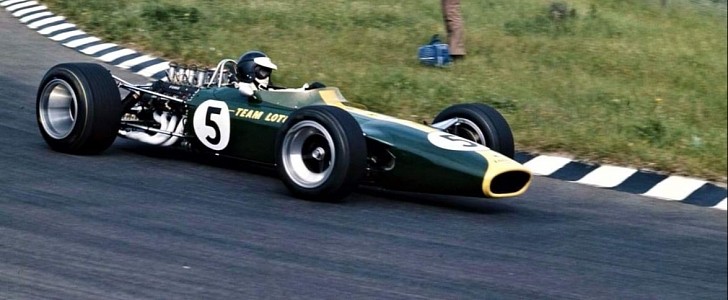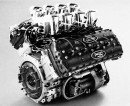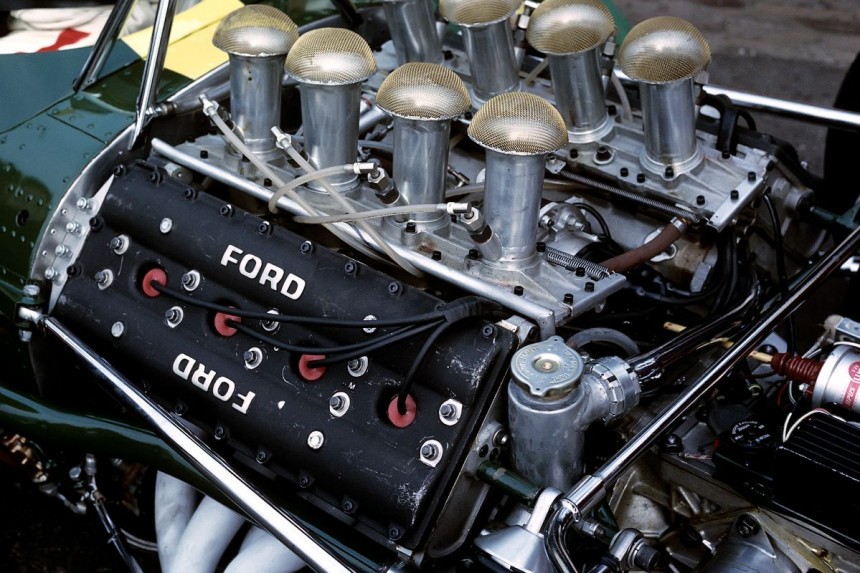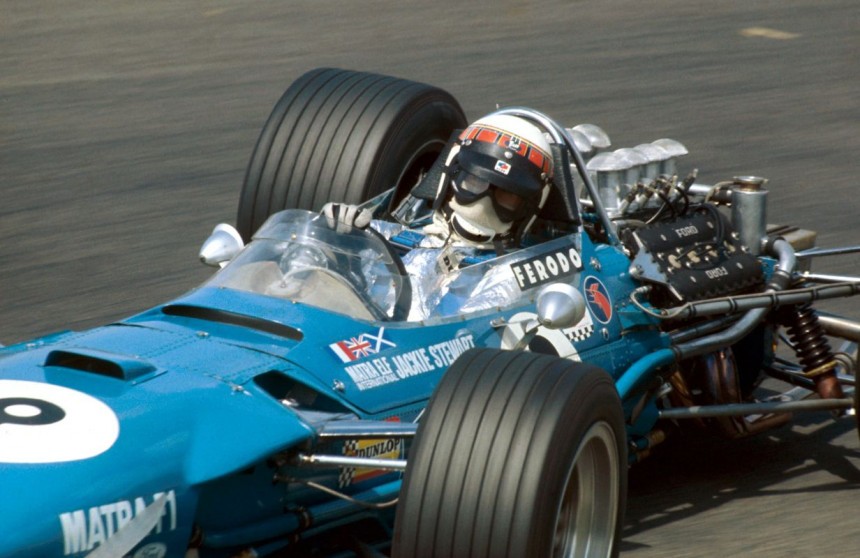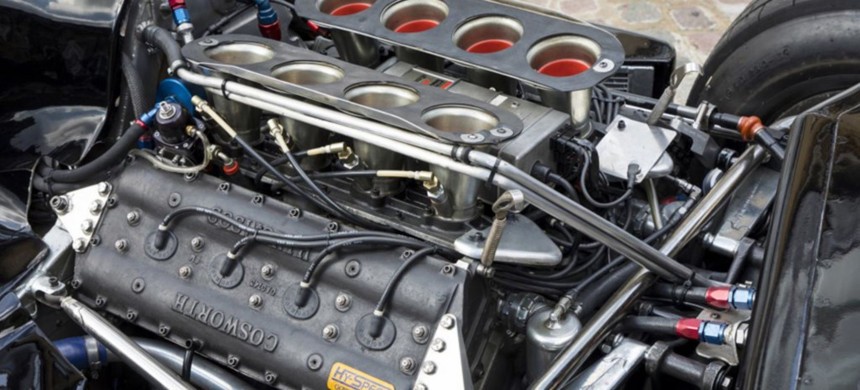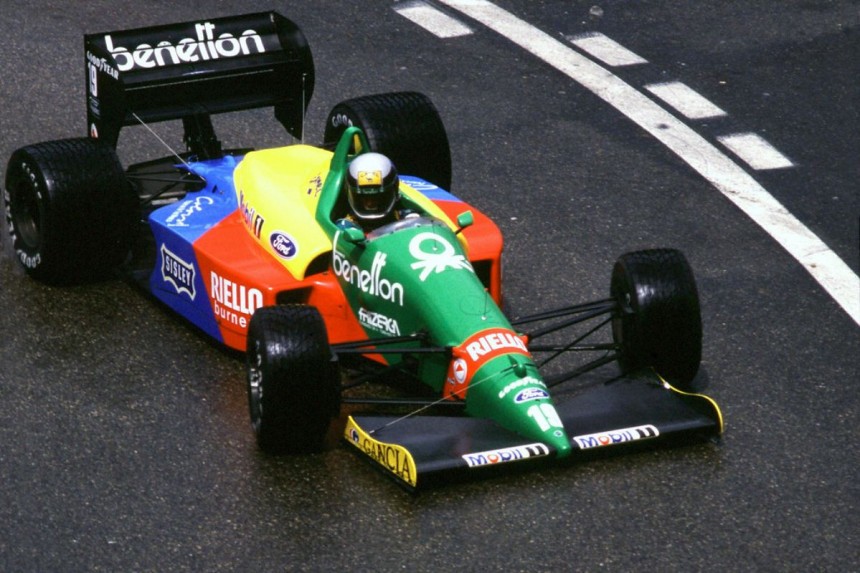Formula 1 is a very swift sport not only in terms of performance but also in regulation changes. It depends a lot on technological involvement, and it is important to give everybody the same chance of winning. The same applies to rules in the engine department. Especially in the last couple of decades, we have seen new types of power units quite often.
However, despite all that, there was an engine that survived over two decades under the same principles that F1 enthusiasts often consider the best powerplant in competition history.
We start way back in the 1960s, which were exciting times for Formula 1. The decade began with regulations that allowed for a 1.5-liter engine at most instead of the 2.5-liter power unit. Team Lotus successfully used a Coventry Climax cross-plane V8 from 1961 until 1965. That year, the FIA changed the regulation again, and the engine displacement increased. Now, F1 was using 3.0-liter power units, and Coventry Climax ended collaboration with the British racing team.
At that moment, Colin Chapman immediately approached Cosworth for help. As a result, they agreed to develop a competitive engine. Still, there wasn't enough money, and Colin Chapman was tasked with finding a £100,000 ($110,000) budget. Maybe it doesn't sound like much, but it would be over $2.6 million in today's money. Collin approached Aston Martin and Ford for funding, but after a negative answer, he tried to convince Ford with a different approach. In the end, Chapman received the green light from Detroit.
The main goal was to create a powerful, light, simple, and reliable engine. Well, that's what everybody aims for, but Cosworth actually managed to develop such a masterpiece. The car was made of aluminum in order to deliver a low weight. The 90-degree V8 block introduced a simple and compact footprint and the twin cams with a four-valve setup. To reach 2,993 cubic centimeters, the power unit had 85.67 by 64.9-millimeter cylinders.
The DFV (Double Four Valve) Cosworth engine didn't use a new, super innovative system or technology. No, not at all. But the DFV was put in such a good way that it was almost unstoppable. As a fun fact, the crankshaft was flat-plane, but the sound of the Cosworth power unit was very gravelly and super addictive. Compared to all the other powerplants, it brought about double the power with 408 hp (414 PS) at 9,000 rpm and 270 lb-ft (370 Nm) of torque.
The DFV Cosworth was introduced in 1965 but was not ready until the 1967 Dutch Grand Prix held at Zandvoort. The first Formula 1 car to use this engine was a Lotus 49, and with Graham Hill behind the wheel, it took the pole position by more than half a second. In the race, Hill led the race for ten laps until a valve train gear failed. Meanwhile, Graham's teammate Jim Clark managed to place his car into the lead and never looked back, winning the Dutch Grand Prix.
In order to understand better the situation from that season, you need to know that Lotus's main rivals were Brabham-Repco. The team founded by Jack Brabham went on to win the constructors' championship as well as the drivers' one with the help of New Zealander Denny Hulme. Meanwhile, the Ferrari cars were overweight and had less power, BRM 16-cylinder was a brilliant idea, but the engine was too complex, heavy, and unreliable. Honda, Maserati, plus all the other teams were either too heavy or too unpredictable.
As a result, the lighter DFV Cosworth-powered Lotus 49 won every pole position, and the domination was just getting started. The failed gear showed up as an anomaly, and the DFV seemed like a super reliable powerplant. By the end of the 1967 F1 season, Ford officials and executives concluded that in order to not look silly winning easily with a brand new power unit, they told Chapman that Lotus no longer had the exclusivity to use the Cosworth engine. I know it sounds pretty weird and stupid, but F1 is as business as any other, and profit is the main objective.
Of course, the American giant manufacturer wanted to sell it at a retail price of £7,500 ($184,000 in 2022 money). Matra immediately called this opportunity, and many other teams, such as McLaren, Brabham, Tyrrell, Williams, and Penske, followed. Between 1967 and 1986, 155 races out of 262 were won by a DFV Cosworth-powered car. That is a significant win margin of 59 percent. In addition, every race during the 1969 and 1973 seasons was dominated by the Ford engine, with both championships being won by Sir Jackie Stewart.
In 1977, the ground effect (the latest innovation in racing engineering) significantly prolonged the lifespan of the DFV. That happened because its cylinders were at a 90-degree angle and far above the ground. It left space for the aerodynamic effect, which was impossible with the flat-12 engines Ferrari and Alfa Romeo used. As a fun fact, many believed that the Italians would crush the competition thanks to the lower center of gravity, but as we know, that wasn't the case.
Even in the early 1980s, the DFVs were still competitive, thanks to the underbody design. However, that era also represents the time when turbocharged engines were emerging, as they were still allowed to participate.
Ferrari attempted to compete with the 1.5-liter V6 powerplants. While they were much more potent in theory, they were hindered by higher weight and worse reliability because of a more significant number of complex parts and poor throttle response.
The turbocharged cars were able to take advantage of the extra power at high-altitude tracks. Still, the instant throttle response of the DFV was dominant on the other circuits, from narrow and twisty corners to high-speed ones, thanks to the ground effect. From 1977 until 1982, the Cosworth DFV engines could still keep up because of how well it was designed and because the turbocharged engines were just getting started.
Furthermore, the already outstanding design was improved over the years. In order to stay at the top of the competition, Cosworth designer Mario Illien reconfigured the cylinder aspect ratio to allow the engine to rev more freely. In addition, he combined this with aluminum liners and a narrow-angle valve setup. As a result, the power output increased to 520 hp (527 PS). Unfortunately, it wasn't enough to keep up with the turbo cars on most tracks.
The final victory of the DFV-family engines was at the 1983 Detroit Grand Prix, where Michele Alboreto basically won by pure luck. Still, the power unit was in use until 1985, but then Cosworth decided to place their efforts on supporting the new turbocharged Ford GBA V6. Funny enough, in 1986, FIA declared that turbo engines would be banned from 1989, so Cosworth revived their elderly power unit design. That's how the DFZ appeared, essentially being an updated version of the DFY. The capacity increased to a 3.5-liter naturally aspirated variant, producing 575 hp (583 PS).
The engine was intended as a temporary solution to help smaller teams over until the turbos were banned at the end of the 1988 season. By the end of 1988, the powerplant was making 590 hp (598 PS). However, this was not the most potent variant because Benneton had been operating as the works Ford team since 1987, and they were using the DFR engine. The only feature carried over from the DFV was the 90-degree V8 architecture.
In 1988, the DFR was the most powerful non-turbo engine, with a power output of 620 hp (629 PS). Still, it was underpowered compared to the turbo powerplants from Ferrari and Honda. Besides F1, the DFV was used in many important motorsports like IndyCar, the 24 Hours of Le Mans, CART, and others.
The Cosworth DFV engine is one of the most successful racing engines ever and most definitely the longest-living in Formula 1. Hundreds of them were built between 1967 and 1993, a big achievement by Cosworth.
We start way back in the 1960s, which were exciting times for Formula 1. The decade began with regulations that allowed for a 1.5-liter engine at most instead of the 2.5-liter power unit. Team Lotus successfully used a Coventry Climax cross-plane V8 from 1961 until 1965. That year, the FIA changed the regulation again, and the engine displacement increased. Now, F1 was using 3.0-liter power units, and Coventry Climax ended collaboration with the British racing team.
At that moment, Colin Chapman immediately approached Cosworth for help. As a result, they agreed to develop a competitive engine. Still, there wasn't enough money, and Colin Chapman was tasked with finding a £100,000 ($110,000) budget. Maybe it doesn't sound like much, but it would be over $2.6 million in today's money. Collin approached Aston Martin and Ford for funding, but after a negative answer, he tried to convince Ford with a different approach. In the end, Chapman received the green light from Detroit.
The main goal was to create a powerful, light, simple, and reliable engine. Well, that's what everybody aims for, but Cosworth actually managed to develop such a masterpiece. The car was made of aluminum in order to deliver a low weight. The 90-degree V8 block introduced a simple and compact footprint and the twin cams with a four-valve setup. To reach 2,993 cubic centimeters, the power unit had 85.67 by 64.9-millimeter cylinders.
The DFV Cosworth was introduced in 1965 but was not ready until the 1967 Dutch Grand Prix held at Zandvoort. The first Formula 1 car to use this engine was a Lotus 49, and with Graham Hill behind the wheel, it took the pole position by more than half a second. In the race, Hill led the race for ten laps until a valve train gear failed. Meanwhile, Graham's teammate Jim Clark managed to place his car into the lead and never looked back, winning the Dutch Grand Prix.
In order to understand better the situation from that season, you need to know that Lotus's main rivals were Brabham-Repco. The team founded by Jack Brabham went on to win the constructors' championship as well as the drivers' one with the help of New Zealander Denny Hulme. Meanwhile, the Ferrari cars were overweight and had less power, BRM 16-cylinder was a brilliant idea, but the engine was too complex, heavy, and unreliable. Honda, Maserati, plus all the other teams were either too heavy or too unpredictable.
As a result, the lighter DFV Cosworth-powered Lotus 49 won every pole position, and the domination was just getting started. The failed gear showed up as an anomaly, and the DFV seemed like a super reliable powerplant. By the end of the 1967 F1 season, Ford officials and executives concluded that in order to not look silly winning easily with a brand new power unit, they told Chapman that Lotus no longer had the exclusivity to use the Cosworth engine. I know it sounds pretty weird and stupid, but F1 is as business as any other, and profit is the main objective.
In 1977, the ground effect (the latest innovation in racing engineering) significantly prolonged the lifespan of the DFV. That happened because its cylinders were at a 90-degree angle and far above the ground. It left space for the aerodynamic effect, which was impossible with the flat-12 engines Ferrari and Alfa Romeo used. As a fun fact, many believed that the Italians would crush the competition thanks to the lower center of gravity, but as we know, that wasn't the case.
Even in the early 1980s, the DFVs were still competitive, thanks to the underbody design. However, that era also represents the time when turbocharged engines were emerging, as they were still allowed to participate.
Ferrari attempted to compete with the 1.5-liter V6 powerplants. While they were much more potent in theory, they were hindered by higher weight and worse reliability because of a more significant number of complex parts and poor throttle response.
Furthermore, the already outstanding design was improved over the years. In order to stay at the top of the competition, Cosworth designer Mario Illien reconfigured the cylinder aspect ratio to allow the engine to rev more freely. In addition, he combined this with aluminum liners and a narrow-angle valve setup. As a result, the power output increased to 520 hp (527 PS). Unfortunately, it wasn't enough to keep up with the turbo cars on most tracks.
The final victory of the DFV-family engines was at the 1983 Detroit Grand Prix, where Michele Alboreto basically won by pure luck. Still, the power unit was in use until 1985, but then Cosworth decided to place their efforts on supporting the new turbocharged Ford GBA V6. Funny enough, in 1986, FIA declared that turbo engines would be banned from 1989, so Cosworth revived their elderly power unit design. That's how the DFZ appeared, essentially being an updated version of the DFY. The capacity increased to a 3.5-liter naturally aspirated variant, producing 575 hp (583 PS).
The engine was intended as a temporary solution to help smaller teams over until the turbos were banned at the end of the 1988 season. By the end of 1988, the powerplant was making 590 hp (598 PS). However, this was not the most potent variant because Benneton had been operating as the works Ford team since 1987, and they were using the DFR engine. The only feature carried over from the DFV was the 90-degree V8 architecture.
The Cosworth DFV engine is one of the most successful racing engines ever and most definitely the longest-living in Formula 1. Hundreds of them were built between 1967 and 1993, a big achievement by Cosworth.
